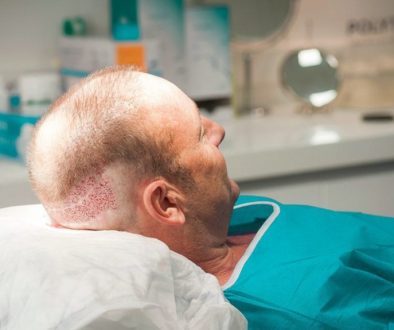Visit to the Farjo clinic in Manchester, England
 After watching Dr. Bessam Farjo and his wife Dr. Nilofer Farjo and their staff in action over two days and two impressive ultra refined surgeries during May of 2007, I was very pleased to see that they have successfully incorporated all of the most important recent advances in hair restoration into their clinic and procedure.
After watching Dr. Bessam Farjo and his wife Dr. Nilofer Farjo and their staff in action over two days and two impressive ultra refined surgeries during May of 2007, I was very pleased to see that they have successfully incorporated all of the most important recent advances in hair restoration into their clinic and procedure.
All of their grafts are carefully trimmed under microscopes, with Dr. Nilofer Farjo closely supervising the medical technicians, while cutting and placing grafts herself. Nilofer is very hands on and does the critical slivering (sectioning of the donor strip into thin “slivers” that are then divided by the technicians into individual follicular unit grafts). She also does most of the primary training and supervising of the medical technicians using the video screen.
 Both Bessam and Nilofer also create all the carefully oriented and minimally invasive graft incisions using custom cut blades that are as small as 0.7mm. Their use of small incisions enables their patients to achieve greater density in a single session, while experiencing quicker healing.
Both Bessam and Nilofer also create all the carefully oriented and minimally invasive graft incisions using custom cut blades that are as small as 0.7mm. Their use of small incisions enables their patients to achieve greater density in a single session, while experiencing quicker healing.
They take a team approach to the surgery with all hands on deck and working harmoniously together. Given the size and skill of the team the clinic can perform large sessions in excess of 3,000 grafts when appropriate for the patient. They typically limit themselves to one patient a day to achieve an optimal level of care.
 Their donor strip removal and Trichophytic closure are also very state of the art with care taken to minimize any follicle transaction or scarring in the donor area. Drs. Bessam and Nilofer Farjo were involved in the early studies/evaluations of the trichophytic closure technique.
Their donor strip removal and Trichophytic closure are also very state of the art with care taken to minimize any follicle transaction or scarring in the donor area. Drs. Bessam and Nilofer Farjo were involved in the early studies/evaluations of the trichophytic closure technique.
To minimize any potential scarring/stretching in the donor area they prefer to remove long but narrow donor strips.
I was particularly impressed by the collaboration of the husband and wife team of Dr. Bessam and Nilofer Farjo. For the patient of the day, it’s like getting two very experienced hair transplant surgeons rather than one. There teaching credits at hair restoration meetings and workshop worldwide are very impressive as are their credentials.
In short, in my opinion, the quality of care and service being provided by the Farjo clinic is on parr with leading clinics in North America.
Read the full report on the Hair Restoration Research Forum.
Technorati Tags: hair restoration, follicular unit grafts, Trichophytic closure




May 5, 2014 @ 3:54 am
Hi there every one, here every one is sharing these kinds of knowledge, thus it’s fastidious to read this web
site, and I used to go to see this web site daily.
August 16, 2010 @ 9:37 pm
Barry,
There is a crescent shaped area in the back (and sides) of each individual’s scalp that is resistant to Dihydrotestosterone (DHT) – the hormone responsible for hair loss. Because of this resistance, these hair do not shed (even if the rest of the scalp hair is lost). When performing a hair transplant procedure, the donor hairs (which are removed and implanted in the balding areas) are taken from this donor area and are no longer susceptible to future loss. However, this does not mean that your remaining native (or natural) hairs will not shed. Because of this, it’s usually wise to investigate preventive methods (such as finasteride – Propecia and minoxidil – Rogaine)in addition to a hair transplant procedure.
I hope this helps!
Blake (Future_HT_Doc)
Editorial Assistant
August 15, 2010 @ 11:03 pm
Barry,
The hair that is transplanted to the balding areas of the scalp is harvested from the permanent zone at the back and sides of the head. This donor hair is genetically programmed to be DHT resistant and will grow for life in the vast majority of men.
Once transplanted, this permanent hair will continue to grow in its new location just as it did before.
However, due to the progressive nature of male pattern balding, the patient may experience continued loss of the native hairs surrounding the transplanted follicular unit grafts.
David (TakingThePlunge)
August 12, 2010 @ 4:07 pm
What guarantees are there that the hormones which caused hair loss will return to cause further hair on transplanted treated areas? If there is no guarantee of possible further hair loss, is there a time limit to coverage of treated hair?
Thanks
Barry